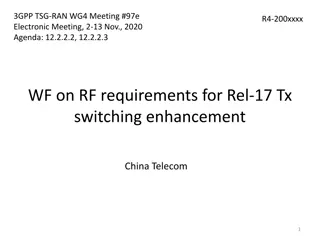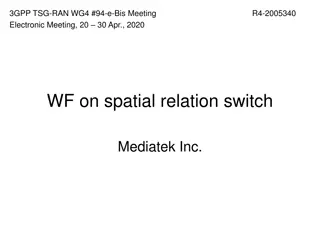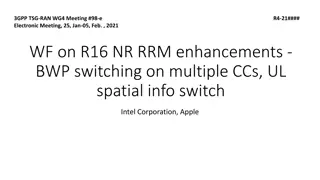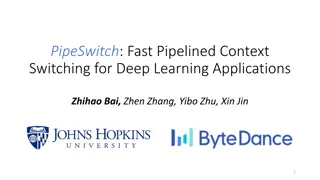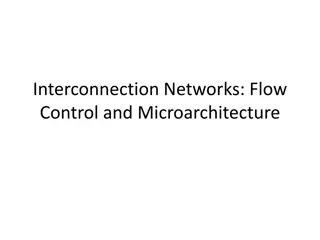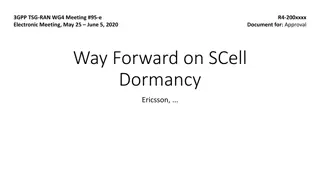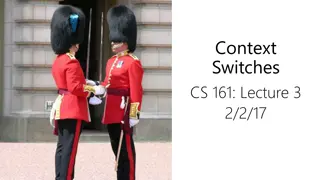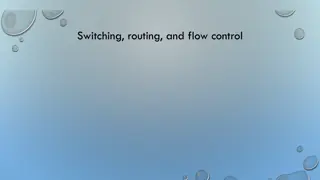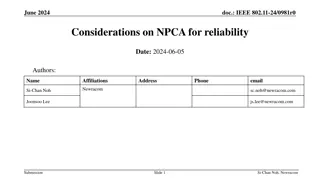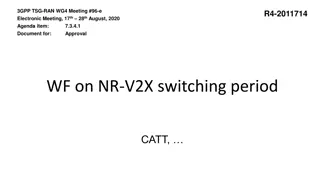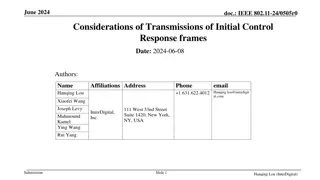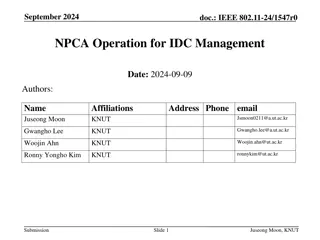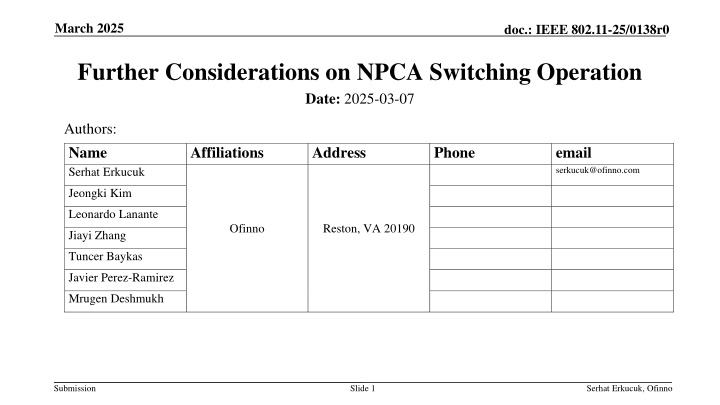
Further Considerations on NPCA Switching Operation in IEEE 802.11-25/0138r0
Explore the considerations for an NPCA STA to switch between primary channels, focusing on scenarios where NPCA AP may need to switch back to the BSS primary channel after the NAV duration ends. Discusses challenges and potential solutions for timely data transmission in NPCA operation.
Download Presentation

Please find below an Image/Link to download the presentation.
The content on the website is provided AS IS for your information and personal use only. It may not be sold, licensed, or shared on other websites without obtaining consent from the author. If you encounter any issues during the download, it is possible that the publisher has removed the file from their server.
You are allowed to download the files provided on this website for personal or commercial use, subject to the condition that they are used lawfully. All files are the property of their respective owners.
The content on the website is provided AS IS for your information and personal use only. It may not be sold, licensed, or shared on other websites without obtaining consent from the author.
E N D
Presentation Transcript
March 2025 doc.: IEEE 802.11-25/0138r0 Further Considerations on NPCA Switching Operation Date: 2025-03-07 Authors: Name Serhat Erkucuk Affiliations Address Phone email serkucuk@ofinno.com Jeongki Kim Leonardo Lanante Ofinno Reston, VA 20190 Jiayi Zhang Tuncer Baykas Javier Perez-Ramirez Mrugen Deshmukh Submission Slide 1 Serhat Erkucuk, Ofinno
March 2025 doc.: IEEE 802.11-25/0138r0 Introduction The conditions for an NPCA STA to switch from a BSS primary channel to an NPCA primary channel has been defined in IEEE P802.11bn /D0.1 [1]. The conditions for an NPCA STA switching back from the NPCA primary channel to the BSS primary channel has not yet been defined in IEEE P802.11bn /D0.1 [1]. However, it is expected that the main consideration for an NPCA STA to switch back to the BSS primary channel should be to switch before the end of the NAV duration on the BSS primary channel. While switching back to the BSS primary channel before the end of the NAV duration helps the NPCA STA fairly contend for the BSS primary channel, some exceptions to this switching back condition may be necessary, where an NPCA AP STA may prefer to operate accordingly. In this contribution, we present some scenarios where an NPCA AP STA may need to switch back to the BSS primary channel after the end of the NAV duration on the BSS primary channel. Submission Slide 2 Serhat Erkucuk, Ofinno
March 2025 doc.: IEEE 802.11-25/0138r0 Arrival of LL Data During NPCA Operation On detecting an inter-BSS PPDU, NPCA AP and NPCA STA may set their basic NAVs on the PCH and switch from the PCH to the NPCA PCH. Then, they perform UL/DL comms. on the NPCA PCH, if the NPCA PCH is available. While on the NPCA PCH, new data may arrive at NPCA AP for transmission to NPCA STA. NPCA AP may determine whether it can transmit the new data (e.g., LL data) before the end of the NAV duration on the PCH. In case NPCA AP determines that it cannot transmit the new data before the end of the NAV duration, it may switch back to the BSS PCH, contends for the channel and transmits the new data after winning the channel access. Arrival of new data ICF PPDU NPCA PCH Switch to PCH PCH NAV NPCA AP New data Switch to NPCA PCH BSS-1 BA ICR Switch to PCH NPCA PCH PCH NAV NPCA STA BA Switch to NPCA PCH NPCA PCH PCH BSS-2 AP/STA OBSS AP/STA communication within BSS-2 Submission Serhat Erkucuk, Ofinno Slide 3
March 2025 doc.: IEEE 802.11-25/0138r0 Problem After Switching Back to Primary Channel As illustrated in the previous example, NPCA AP may transmit the new data after switching back to the BSS primary channel. However, when the NPCA AP and the NPCA STA switch back from the NPCA PCH to the PCH, NPCA AP may not always be able to win the channel access, and thus, may observe the PCH to be busy (e.g., another OBSS STA may already be communicating). Not winning the channel access, NPCA AP may not be able to transmit the new data to the NPCA STA timely. The new data may be discarded or lost. Arrival of new data Discarding new data ICF PPDU NPCA PCH Switch to PCH PCH NAV NPCA AP Busy Switch to NPCA PCH BSS-1 BA ICR Switch to PCH NPCA PCH PCH NAV NPCA STA Busy Switch to NPCA PCH NPCA PCH PCH BSS-2 AP/STA OBSS AP/STA communication within BSS-2 Submission Serhat Erkucuk, Ofinno Slide 4
March 2025 doc.: IEEE 802.11-25/0138r0 Switching Back to PCH after the NAV duration As one solution, NPCA AP may determine a new switch back time (beyond the NAV duration) and transmit the new data before switching back to the BSS primary channel. On receiving the frame containing the new data, NPCA STA updates its switch back time. NPCA AP and NPCA STA switch back at the new switch back time. As another solution, NPCA AP may transmit a frame to announce the new switch back time to its associated NPCA STAs before transmitting the new data. Arrival of new data New data ICF Switch to PCH PPDU NPCA PCH PCH NAV NPCA AP Switch to NPCA PCH BSS-1 BA ICR Switch to PCH NPCA PCH PCH NAV NPCA STA Switch to NPCA PCH NPCA PCH PCH BSS-2 AP/STA OBSS AP/STA communication within BSS-2 Submission Serhat Erkucuk, Ofinno Slide 5
March 2025 doc.: IEEE 802.11-25/0138r0 Updating Switch Back Time for Short TXOP Duration In another scenario, new data may have arrived at NPCA AP for transmission to NPCA STA while on the PCH, but the NPCA AP may not have the channel access on the PCH. As NPCA AP switches to the NPCA PCH, it may determine that the time required to transmit the new data exceeds the duration of OBSS activity on the PCH. NPCA AP may then determine a new switch back time (beyond the NAV duration) and transmit the new data before switching back to the BSS primary channel. NPCA AP may announce the new switch back time to its associated NPCA STAs while transmitting the new data or before transmitting the new data. Arrival of new data New data ICF NPCA PCH Switch to PCH PCH NAV NPCA AP Switch to NPCA PCH BSS-1 BA ICR Switch to PCH NPCA PCH PCH NAV NPCA STA Switch to NPCA PCH NPCA PCH PCH BSS-2 AP/STA OBSS AP/STA comm. within BSS-2 Submission Serhat Erkucuk, Ofinno Slide 6
March 2025 doc.: IEEE 802.11-25/0138r0 Conclusion In this contribution, we considered some scenarios where an NPCA AP may need to switch back to the BSS primary channel after the NAV duration (e.g., same as the duration of OBSS activity) on the BSS primary channel. While the baseline for an NPCA STA to switch back to the BSS primary channel should be to switch before the end of the NAV duration on the BSS primary channel, some exceptions to this switching back condition may be defined: E.g., if an NPCA AP determines the duration required to transmit buffered data (e.g., LL data) on the NPCA primary channel to exceed the duration of the OBSS activity on the BSS primary channel. TBD some other conditions Defining some exceptions to switching back to the BSS primary channel before the end of OBSS activity may be helpful especially when there is buffered low latency traffic at the NPCA AP. Submission Slide 7 Serhat Erkucuk, Ofinno
March 2025 doc.: IEEE 802.11-25/0138r0 References [1] IEEE P802.11bn /D0.1, January 2025 Submission Slide 8 Serhat Erkucuk, Ofinno
March 2025 doc.: IEEE 802.11-25/0138r0 Straw Poll 1 Do you agree to add the following text to the TGbn SFD? NPCA AP that has switched to the NPCA primary channel shall be switched back to the BSS primary channel before the expected duration of the OBSS activity that makes the BSS primary channel busy ends, unless NPCA AP has buffered data that cannot be transmitted on the NPCA primary channel before the expected duration of the OBSS activity that makes the BSS primary channel busy ends. Buffered data may be low latency data. Yes No Abstain Y/N/A: Submission Slide 9 Serhat Erkucuk, Ofinno



